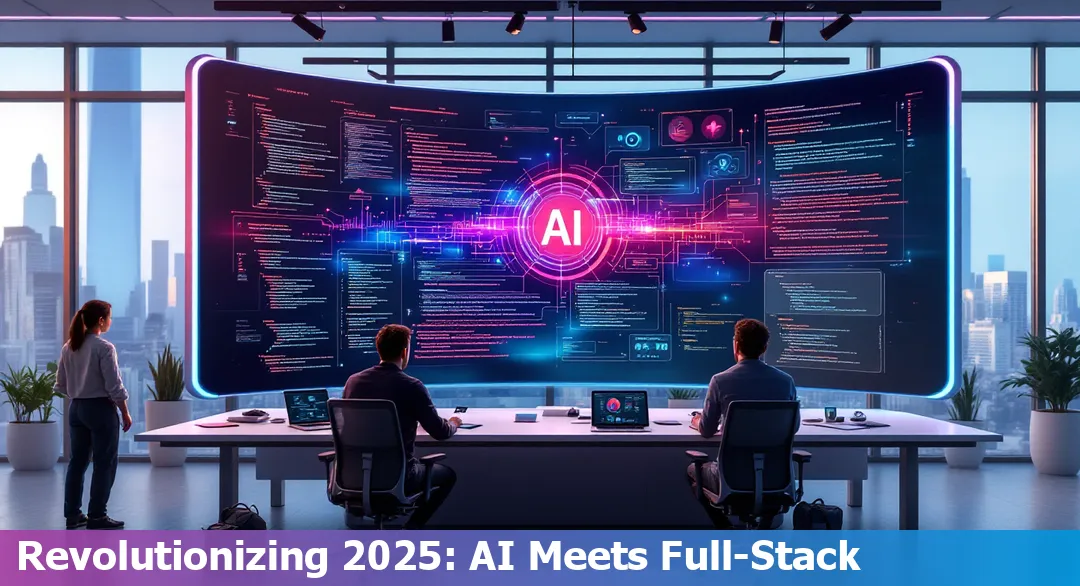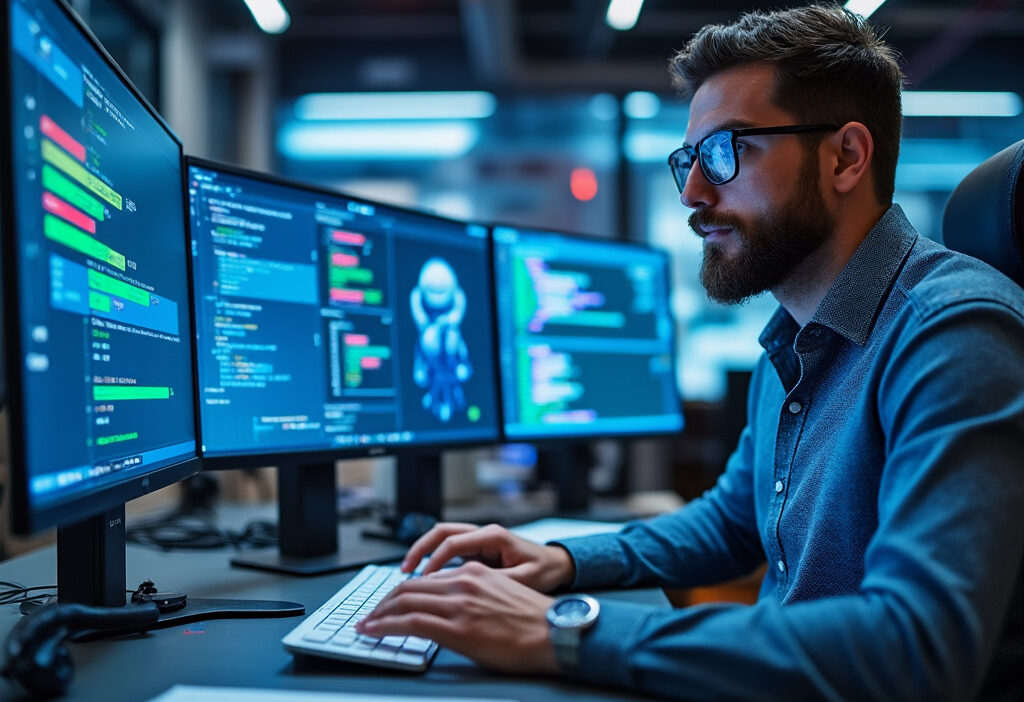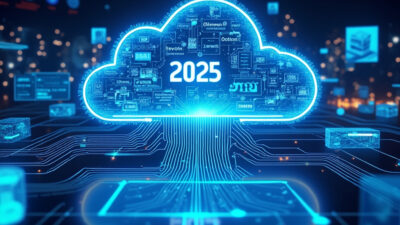Revolutionizing Developer Experience: How AI Is Transforming the Way We Code in 2025
As we navigate through 2025, the developer landscape is witnessing a profound transformation, primarily driven by artificial intelligence (AI). AI tools have advanced from being mere code completers to sophisticated collaborators, dramatically altering how software is constructed, debugged, and deployed. This evolution has not only refined the tools at developers’ disposal but has also reshaped their roles within the software development lifecycle.
The Evolution of AI in Software Development
The evolution of AI in software development has been a journey of incremental breakthroughs, each reshaping how developers interact with code. In the early 2010s, AI-assisted tools were limited to basic autocompletion and syntax suggestions. By the mid-2020s, however, generative AI models like OpenAI’s Codex and GitHub’s Copilot transformed coding from a manual, line-by-line process into a collaborative effort between human intuition and machine intelligence. These tools didn’t just predict the next line—they generated entire functions, debugged complex logic, and even proposed architectural optimizations.
The shift was accelerated by advancements in large language models (LLMs), which learned from vast repositories of open-source code. Developers no longer needed to memorize APIs or boilerplate; instead, they could describe intent in natural language and let AI draft the implementation. This didn’t eliminate the need for expertise—it redirected it. Coders now spent less time on repetitive tasks and more on refining AI outputs, ensuring correctness, and integrating solutions into larger systems.
Key milestones included the rise of context-aware AI, which understood project-specific patterns, and self-improving systems that learned from user feedback. The developer ecosystem evolved too, with tools like AI-powered IDEs offering real-time performance analysis and security vulnerability detection. However, this progress wasn’t without challenges. Early AI models occasionally produced inefficient or insecure code, forcing developers to sharpen their review skills. The balance shifted from writing code to curating it—a subtle but profound change in the developer’s workflow.
By 2025, AI had become an indispensable partner, blending automation with human creativity. The next phase of this transformation would redefine not just how code was written, but who—or what—was considered a “developer.”
Redefining the Developer’s Role
In 2025, the role of a software developer has undergone a profound transformation, shifting from hands-on coding to a more strategic and supervisory position. AI-powered tools now handle the bulk of code generation, allowing developers to focus on higher-level tasks such as architecture design, problem-solving, and innovation. Rather than writing every line manually, developers now curate AI-generated code—refining outputs, ensuring alignment with project goals, and optimizing for performance and scalability.
This shift demands a deeper understanding of AI logic and its limitations. Developers must be adept at interpreting AI suggestions, identifying biases in training data, and ensuring ethical implementations. For instance, an AI might generate efficient but insecure code, or inadvertently introduce biases in decision-making algorithms. The modern developer’s expertise lies in scrutinizing these outputs, applying domain knowledge, and making nuanced adjustments that AI alone cannot.
Moreover, creativity has become a cornerstone of the developer’s role. With repetitive tasks automated, engineers now spend more time on innovative design, user experience enhancements, and solving complex, domain-specific challenges. Collaboration between humans and AI has also evolved—developers act as orchestrators, guiding AI tools to produce coherent, maintainable solutions while maintaining oversight over system integrity.
This evolution doesn’t diminish the developer’s importance; instead, it elevates their responsibilities. Mastery of AI-assisted workflows, ethical considerations, and strategic thinking are now as critical as coding proficiency once was. The developer of 2025 is less a coder and more a problem-solver, leveraging AI as a powerful ally in building the next generation of software.
AI Development Tools and Their Impact
In 2025, AI development tools have become indispensable in the software development lifecycle, reshaping workflows and elevating both efficiency and code quality. The most impactful tools leverage advanced language models, capable of generating, debugging, and testing code with near-human precision. These AI assistants, such as GitHub Copilot X and Amazon CodeWhisperer Pro, now integrate seamlessly into IDEs, offering real-time suggestions that go beyond boilerplate code—they architect entire modules based on high-level descriptions.
One of the most transformative advancements is AI-driven debugging. Tools like DeepCode AI and Sentry’s Autofix analyze runtime errors, suggest fixes, and even implement patches autonomously, reducing debugging time by over 60%. Testing has also been revolutionized, with AI frameworks like TestGenius automatically generating comprehensive test suites, including edge cases developers might overlook. This not only accelerates release cycles but also minimizes post-deployment bugs.
The impact on workflows is profound. Developers now spend less time on repetitive tasks and more on refining AI outputs, ensuring alignment with project goals and ethical standards. For instance, AI-generated code often requires optimization for performance or compliance, a task demanding deep technical expertise. Additionally, tools like AI Pair provide contextual mentorship, helping junior developers upskill by explaining complex logic in real time.
However, reliance on AI tools introduces new challenges. Teams must rigorously validate AI suggestions to avoid propagating biases or security vulnerabilities embedded in training data. Despite this, the net effect is undeniable: AI tools have democratized high-quality software development, enabling smaller teams to compete with tech giants by automating labor-intensive processes. As we transition into the era of vibe coding, these tools will further lower barriers, allowing even non-coders to articulate ideas and receive functional code. The future of development isn’t just about writing code—it’s about orchestrating AI to build smarter, faster, and more inclusively.
Vibe Coding: A New Paradigm
The rise of vibe coding marks a fundamental shift in how developers approach software creation in 2025. Unlike traditional coding, which requires deep technical expertise, vibe coding leverages AI to translate high-level problem descriptions into functional code. Developers no longer need to meticulously write every line—instead, they articulate their intent in natural language, and AI models generate the corresponding logic, structure, and even optimizations. This paradigm lowers the barrier to entry, enabling non-experts to prototype and build software while allowing seasoned developers to focus on higher-level design and innovation.
At its core, vibe coding relies on advanced language models that understand context, infer requirements, and produce syntactically correct, maintainable code. For example, a developer might describe a feature like “a login system with OAuth 2.0 and rate limiting”, and the AI generates a secure, scalable implementation. The implications are profound: repetitive boilerplate coding diminishes, debugging becomes more about refining intent than fixing syntax, and development speed increases exponentially.
However, this shift isn’t without challenges. While AI handles the mechanics, developers must still ensure the generated code aligns with project goals, performance constraints, and ethical considerations—a theme that bridges to the next chapter on human-AI collaboration. Vibe coding also raises questions about intellectual ownership and the role of traditional coding skills. Yet, as the tools mature, they’re fostering a new era of creative problem-solving, where developers act more as architects and reviewers than manual coders. The result? A more inclusive, efficient, and dynamic software landscape where ideas—not just technical prowess—drive innovation.
Navigating the AI-Developer Collaboration
The rise of AI in software development has redefined the collaboration between developers and machines, creating a symbiotic relationship where each plays a crucial role. In 2025, AI is no longer just a tool—it’s a partner, capable of understanding context, generating code, and even suggesting architectural improvements. However, this partnership comes with challenges, particularly in ensuring AI-generated solutions align with human intent and ethical standards.
One of the biggest hurdles is intent alignment. While AI can produce functional code, it may not always grasp the nuanced requirements or business logic behind a task. Developers must refine their ability to articulate problems clearly, using natural language or structured prompts that guide AI toward the desired outcome. Techniques like iterative refinement—where developers progressively adjust AI outputs through feedback loops—have become essential.
Another critical aspect is trust and transparency. AI-generated code often operates as a black box, making it difficult to verify correctness or security. To mitigate this, modern IDEs now integrate explainability features, allowing developers to trace how AI arrived at a solution. Pair programming with AI—where the system justifies its logic in real time—has also gained traction, fostering a deeper understanding of AI decision-making.
Ethical alignment is equally vital. AI models trained on biased or flawed datasets can propagate harmful patterns. Developers must actively audit AI suggestions, applying ethical frameworks to ensure fairness and compliance. Tools like AI governance plugins automatically flag potential ethical violations, but human oversight remains irreplaceable.
The future of AI-developer collaboration hinges on balanced co-creation. By combining human creativity with AI’s efficiency, teams can innovate faster while maintaining control over quality and ethics. This dynamic sets the stage for the next challenge: navigating the ethical minefields of AI-assisted development.
Ethical Considerations in AI-Assisted Development
As AI becomes deeply embedded in software development, ethical considerations take center stage. The convenience of AI-assisted coding comes with risks—bias in training data, opaque decision-making, and unclear accountability—that developers must proactively address. Bias remains a critical concern; AI models trained on historical codebases may perpetuate outdated practices or exclude underrepresented perspectives. For example, code suggestions favoring certain programming styles over others could inadvertently marginalize developers from diverse backgrounds.
Accountability is another gray area. When AI-generated code introduces vulnerabilities or fails, who bears responsibility—the developer, the AI vendor, or the organization? The lack of transparency in how AI models arrive at solutions complicates this further. Developers must scrutinize AI outputs, treating them as suggestions rather than absolutes, and maintain rigorous testing protocols.
To mitigate these risks, teams should adopt ethical frameworks tailored to AI-assisted development. This includes:
- Auditing datasets for bias and ensuring diverse representation in training data.
- Documenting AI interactions to create traceability for decisions influenced by AI.
- Prioritizing explainability by choosing tools that provide clear rationales for their suggestions.
Ethical AI use also demands ongoing education. Developers must stay informed about emerging ethical guidelines, such as those from the ACM or IEEE, and advocate for transparency in the tools they adopt. By embedding ethical vigilance into workflows, developers can harness AI’s power without compromising integrity—a necessity as the industry moves toward the skillset of the future, where ethical literacy will be as vital as technical prowess.
The Skillset of the Future Developer
The rapid integration of AI into software development has redefined the skillset required for developers in 2025. While traditional coding expertise remains foundational, the modern developer must now master a broader, interdisciplinary range of competencies to thrive in an AI-augmented environment.
Technical Proficiency still starts with programming languages, but Python, JavaScript, and Rust dominate due to their compatibility with AI frameworks like TensorFlow, PyTorch, and LangChain. Developers must also understand cloud-native architectures, as AI models increasingly rely on scalable cloud infrastructure from providers like AWS, Google Cloud, and Azure. Containerization (Docker, Kubernetes) and serverless computing are no longer optional but essential for deploying AI-driven applications efficiently.
Beyond coding, data literacy is critical. Developers need a working knowledge of data preprocessing, feature engineering, and basic statistical analysis to collaborate effectively with data scientists. Familiarity with AI model fine-tuning and prompt engineering for generative AI tools is equally important, as these skills bridge the gap between raw code and intelligent system behavior.
However, technical skills alone are insufficient. AI ethics and governance—though touched on in the previous chapter—must be practically applied. Developers should understand bias mitigation techniques, model explainability, and compliance frameworks like GDPR or the EU AI Act. Soft skills, such as problem-solving and adaptability, are amplified in importance, as AI tools evolve rapidly, requiring continuous learning.
Lastly, cross-disciplinary collaboration is key. Developers must communicate complex AI concepts to non-technical stakeholders while integrating feedback into iterative development cycles. The future developer isn’t just a coder but a hybrid technologist—equally comfortable with algorithms, ethics, and teamwork—poised to leverage AI as both a tool and a collaborator.
The Impact of AI on Developer Productivity and Creativity
The integration of AI into software development has fundamentally reshaped how developers approach their work, unlocking unprecedented levels of productivity and creativity. By automating repetitive tasks, AI tools allow developers to focus on higher-level problem-solving and innovation. For instance, AI-powered code completion tools like GitHub Copilot and Amazon CodeWhisperer have drastically reduced boilerplate coding time, enabling developers to write functional code snippets in seconds rather than hours. Studies show that such tools can cut development cycles by up to 40%, freeing up time for more strategic design decisions.
Beyond efficiency, AI enhances accuracy. Advanced debugging tools now leverage machine learning to predict and fix errors before they reach production. Google’s DeepCode and Microsoft’s IntelliCode analyze vast repositories to suggest optimizations, reducing bug resolution time by over 50%. This shift minimizes technical debt and lets developers experiment more boldly, knowing AI acts as a safety net.
Creativity flourishes when mundane tasks are automated. AI-driven design assistants, such as Figma’s AI-powered prototyping tools, generate UI mockups based on natural language prompts, allowing developers to iterate rapidly. Similarly, AI-powered testing frameworks like Testim.io automate test case generation, ensuring robustness while freeing developers to refine user experience.
The synergy between human ingenuity and AI’s analytical power is redefining software development. As AI handles the grunt work, developers can explore novel architectures, experiment with emerging paradigms like quantum computing integration, and push the boundaries of what’s possible. This transformation isn’t just about speed—it’s about elevating the craft of coding to new creative heights.
Preparing for a Future Dominated by AI in Software Development
As AI continues to reshape software development, developers must proactively adapt to remain relevant in an evolving field. The rapid integration of AI tools demands a shift in mindset—from merely using AI as an assistant to embracing it as a core component of the development lifecycle. To stay ahead, developers should focus on three key strategies: continuous learning, active participation in AI communities, and hands-on experimentation with emerging technologies.
Continuous learning is no longer optional. AI advancements occur at a breakneck pace, and developers must cultivate a habit of lifelong education. This includes mastering AI-assisted coding tools like GitHub Copilot and Amazon CodeWhisperer, understanding their limitations, and learning how to fine-tune them for specific use cases. Online courses, certifications, and workshops on machine learning, natural language processing, and AI ethics will become essential for maintaining a competitive edge.
Engaging with AI development communities is equally critical. Platforms like GitHub, Stack Overflow, and specialized AI forums provide invaluable insights into real-world applications, best practices, and troubleshooting. Contributing to open-source AI projects or sharing knowledge through blogs and talks can deepen expertise while fostering professional networks.
Finally, developers should explore new AI technologies beyond coding assistants. Experimenting with AI-driven debugging, automated testing frameworks, and AI-powered project management tools can uncover efficiencies that streamline workflows. By staying curious and adaptable, developers can position themselves not just as users of AI but as innovators who shape its future role in software development.
The next phase of AI in development will demand more than technical proficiency—it will require a proactive approach to integrating AI into every facet of the craft. Those who embrace this shift will lead the charge in defining the future of coding.
AI in Software Development: Looking Ahead
By 2025, AI’s role in software development is poised to transcend its current capabilities, reshaping not just how we code but the very fabric of the development lifecycle. Autonomous coding systems will evolve beyond today’s code assistants, capable of independently architecting entire applications based on high-level requirements. These systems will leverage advanced natural language processing to interpret ambiguous specifications, filling gaps with context-aware logic—reducing human intervention to oversight and refinement.
AI-driven project management will become predictive rather than reactive. Tools will analyze historical project data, team dynamics, and even developer sentiment to forecast bottlenecks before they occur. Real-time AI optimizations could redistribute tasks dynamically, ensuring optimal productivity without human micromanagement. This shift will free developers from administrative overhead, allowing them to focus on creative problem-solving.
The implications for software quality are profound. AI will not only detect bugs but preemptively refactor code to avoid them, learning from global codebases to enforce best practices. Generative testing will simulate edge cases humans might overlook, ensuring robustness at scale. However, this raises questions about innovation: Will over-reliance on AI homogenize solutions, or will it amplify human creativity by handling mundane tasks?
Developer roles will bifurcate. While some will specialize in AI wrangling—training and fine-tuning models for specific domains—others will transition into higher-level design and ethical oversight, ensuring AI outputs align with business and societal values. The divide between “coders” and “architects” will blur, as AI handles implementation details while humans steer vision.
The future isn’t just about faster coding—it’s about redefining collaboration between human intuition and machine precision, unlocking unprecedented agility and quality in software creation.

Conclusions
Throughout 2025, AI has undisputedly revolutionized the developer experience, turning science fiction into reality. By enhancing productivity, reducing errors, and accelerating the development process, AI has established itself as an indispensable ally in software engineering. The trajectory of this revolution suggests a future where developers and AI co-create in unprecedented harmony, pushing the boundaries of innovation further than ever before.



